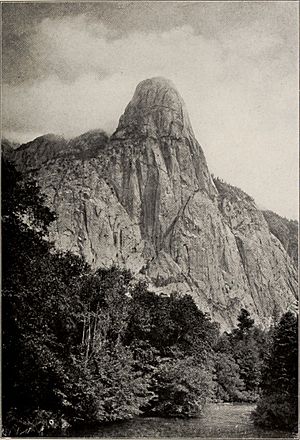Tehipite Valley facts for kids
Tehipite Valley is a beautiful valley found in Kings Canyon National Park in California. It is part of the amazing Sierra Nevada mountains. This valley was carved by glaciers long ago, and the Middle Fork Kings River flows through it.
Tehipite Valley is located in Fresno County. It is about 45 miles (72 km) southwest of Bishop and 60 miles (97 km) east of Fresno. People often compare its stunning views to those of Yosemite Valley. It is also known for being very remote and hard to reach.
Exploring Tehipite Valley's Geography
Tehipite Valley is about 1.5 miles (2.4 km) long and up to 0.75 miles (1.21 km) wide. It has very tall, steep granite walls, deep side canyons, and beautiful waterfalls. Many people, including famous naturalist John Muir, have said its scenery looks a lot like Yosemite Valley. John Muir first visited this area in the 1870s.
The valley sits just inside the western edge of Kings Canyon National Park. It is also on the northern side of the Monarch Wilderness. The Middle Fork Kings River flows quickly through the valley from northeast to southwest. The valley floor is about 4,200 feet (1,300 m) high. The mountains around it rise to 8,000 feet (2,400 m) or more.
The north side of Tehipite Valley is dominated by Tehipite Dome. This is the largest granite dome in the Sierra Nevada mountains. It rises an amazing 3,500 feet (1,100 m) above the valley floor. Other cool spots in the valley include Silver Spray and Blue Canyon Falls. These are both waterfalls that drop hundreds of feet. There is also the "Gorge of Despair," formed by Crystal Creek. This gorge is very rugged and hard to get to. It is known for some of the best rock climbing in the Sierra Nevada.
The History of Tehipite Valley
The valley got its name in 1869 from Frank Dusy. He used a Native American name for Tehipite Dome, which means "high rock." Dusy's team was also the first to take photos of the valley in 1879. Even though Dusy is often said to be the first non-native person to visit, he wrote in his journal that he followed a trail. This trail might have been used by gold prospectors a few years earlier.
Lilbourne A. Winchell was part of Dusy's 1879 trip. He wrote about how amazing the valley looked when they first saw it. He described looking down into the valley from a high cliff. The Middle Fork river looked tiny from above. He also saw huge, snow-capped mountains in the distance.
In 1897, Theodore S. Solomon made one of the first maps of the valley. On this map, he first mentioned the "Gorge of Despair."
In the 1920s, the City of Los Angeles wanted to build a hydroelectric dam in Tehipite Valley. This idea caused a lot of debate before and after Kings Canyon National Park was created. When President Franklin D. Roosevelt officially opened the park on March 4, 1940, Tehipite Valley was not included. It was not until 1965 that Tehipite Valley and Cedar Grove were finally added to the park. This made sure they would be protected forever from industrial projects like dams.
How to Visit Tehipite Valley
Tehipite Valley is known for being very remote. It is many miles from the closest paved road, which is Highway 180. Some days, no one visits the valley at all because it is so hard to reach.
One of the main paths to the valley is the Tehipite Valley Trail. This trail starts near the access road for Wishon Dam. The National Park Service says the hike to the valley rim is "moderate." However, the path going down into the valley is "very strenuous." Because the trails are so high up and get a lot of snow in winter, Tehipite Valley can be impossible to reach for up to eight months of the year. Many trails have also become worn out, making access even harder. Also, the area is known for rattlesnakes, so hikers need to be careful.
There are simple campsites in the valley, located along the Middle Fork Kings River.


